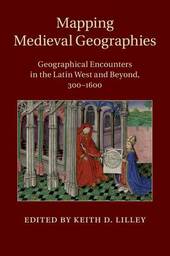
|
Mapping Medieval Geographies: Geographical Encounters in the Latin West and Beyond, 300-1600
Paperback / softback
Main Details
| Title |
Mapping Medieval Geographies: Geographical Encounters in the Latin West and Beyond, 300-1600
|
| Authors and Contributors |
Edited by Keith D. Lilley
|
| Physical Properties |
| Format:Paperback / softback | | Pages:348 | | Dimensions(mm): Height 230,Width 152 |
|
| Category/Genre | Cartography, map-making and projections |
|---|
| ISBN/Barcode |
9781316620274
|
| Classifications | Dewey:940.1 |
|---|
| Audience | | Professional & Vocational | |
|---|
| Illustrations |
27 Halftones, black and white
|
|
Publishing Details |
| Publisher |
Cambridge University Press
|
| Imprint |
Cambridge University Press
|
| Publication Date |
11 August 2016 |
| Publication Country |
United Kingdom
|
Description
Mapping Medieval Geographies explores the ways in which geographical knowledge, ideas and traditions were formed in Europe during the Middle Ages. Leading scholars reveal the connections between Islamic, Christian, Biblical and Classical geographical traditions from Antiquity to the later Middle Ages and Renaissance. The book is divided into two parts: Part I focuses on the notion of geographical tradition and charts the evolution of celestial and earthly geography in terms of its intellectual, visual and textual representations; whilst Part II explores geographical imaginations; that is to say, those 'imagined geographies' that came into being as a result of everyday spatial and spiritual experience. Bringing together approaches from art, literary studies, intellectual history and historical geography, this pioneering volume will be essential reading for scholars concerned with visual and textual modes of geographical representation and transmission, as well as the spaces and places of knowledge creation and consumption.
Author Biography
Keith Lilley is Reader in Historical Geography at Queen's University Belfast. His research focuses on spaces, places and landscapes of the European Middle Ages. He has published essays and articles across different disciplines, and is the author of two other books, Urban Life in the Middle Ages (2002) and City and Cosmos: The Medieval World in Urban Form (2009). He is a Fellow of the Royal Historical Society and has directed numerous funded research projects in the field of digital humanities, including a project on the UNESCO-recognised fourteenth-century map of Great Britain known as the Gough Map. In this and other projects he has developed the use of spatial technologies to further understand the medieval past. For more than twenty years he has taught geography at undergraduate and postgraduate levels at a number of UK universities, including the University of London, the University of Birmingham and the University of Cambridge. At Queen's University Belfast he is director of a postgraduate programme on 'Heritage Science'. Through his work he has addressed conferences and delivered seminars across Europe and in North America, Japan and Australia.
Reviews'In Mapping Medieval Geographies Keith D. Lilley has brought together a broad spectrum of scholars to explore both the medieval engagement with geography as a practice and as a subject of inquiry as well as the imagined geographies of those who inhabited the Latin, Greek, and Arabic worlds of the Middle Ages. These essays are unusual in the respect that they show for the alternate geographies of the Middle Ages even while embedding their analyses within contemporary geographical discourse.' Patrick J. Geary, Institute for Advanced Study, Princeton 'This volume demonstrates clearly that geographical knowledge includes more than maps projected according to Ptolemaic theory and that medieval geographers working in the tradition of chorography produced work of significance. To limit geography to the Ptolemaic tradition is to miss out on a great deal of geographical knowledge.' James Muldoon, The John Carter Brown Library '... an interesting and unusual collection of studies ... Highly recommended.' G. J. Martin, Choice 'This collection will provide an invaluable gathering of current research, as well as a stimulating and demanding read for the broader range of scholars and students who wish to progress beyond the basic understandings of the 'spatial turn' to a broader understanding of medieval geographies.' Justin Colson, Reviews in History
|